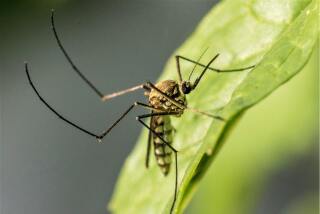Housing Plan Raises Prospect of Illness
As part of their evaluation of the massive Hidden Creek Ranch housing project, city officials tonight will grapple with the prospect of valley fever arising during construction.
A staff report to be presented during the 7 p.m. City Council session draws no conclusion on the issue.
However, it points out that construction workers are among those with âan increased risk of exposureâ to the flu-like illness.
The council had requested more information on valley fever after it found inadequate treatment of the problem in an environmental impact report.
âMy question is, does valley fever represent a significant threat?â said Mayor Pat Hunter. âAnd until we have the answer, I will continue to pursue the question.â
Workers building the 3,200-home Hidden Creek project would have to excavate nearly 26 million cubic yards of dirt. The fungal spores that cause valley fever are found around rodent burrows and burial grounds, and can become airborne when soil is disturbed.
In 60% of valley fever cases, the disease resembles a mild cold. The remaining 40% of cases can involve a range of illnesses, from flu-like symptoms to pneumonia. A few sufferers contract meningitis, an inflammation of the membranes that envelop the brain and spinal cord. In rare cases, it is fatal.
After the 1994 Northridge earthquake, valley fever cases were heavily concentrated in Simi Valley, according to the report.
âBoth the timing and location of the valley fever cases following the Northridge earthquake were believed to be a result of the dust generated by landslides caused by the earthquake and the prevailing winds,â the report says.
There were eight cases of valley fever in Moorpark following the Northridge earthquake, according to the report. Since 1994, none have been reported.
More to Read
Sign up for Essential California
The most important California stories and recommendations in your inbox every morning.
You may occasionally receive promotional content from the Los Angeles Times.










